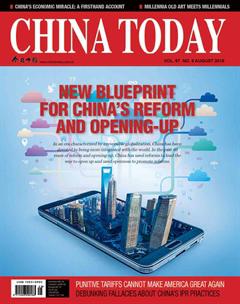economy
Shortened Negative Lists for Foreign Investment Unveiled
China unveiled a shortened negative list for foreign investment on June 28, with the number of restricted items down to 48 from 63 in the previous version.
Jointly released by the National Development and Reform Commission (NDRC) and the Ministry of Commerce, the new negative list became effective on July 28.
The new list widens market access for foreign investment in primary, secondary, as well as tertiary sectors, detailing 22 opening-up measures in fields including finance, transportation, professional services, infrastructure, energy, resources, and agriculture.
The new list also details a timetable for opening-up in the automobile and finance sectors, the commission said.
China also unveiled a new negative list for foreign investment in the countrys pilot free trade zones (FTZs) on June 30, with the number of items down to 45 from 95 in the previous version. The new list became effective on July 30.
Compared with opening-up measures detailed in a nationwide list that was made public on June 28, the latter list that applies to FTZs further removes or loosens foreign access restrictions in fields including agriculture and mining, according to an NDRC statement.
Media Industry to Hit RMB 3 Trillion by 2020
The gross market value of Chinas media industry is expected to reach RMB 3 trillion (over US$460 billion) by 2020, according to a report released by Tsinghua University.
The market value of the industry grew 16.6 percent over 2016 to nearly RMB 1.9 trillion in 2017, the report shows.
“Along with the further integration of traditional media outlets and the Internet, the media industry has now become an important part of Chinas digital economy,” said Professor Cui Baoguo of Tsinghua University.
Cui added that Chinese consumers are spending more money on media and cultural fields.
Consumers who pay for online content, and those who are willing to spend money to support their idols, will drive the growth of the media industry in the future, the report says.
Three-year Transport Development Plan to Be Implemented
China will implement a threeyear action plan to improve its transport network and services, according to the Ministry of Transport.
The plan reaffirms Chinas goals of building a fully-fledged transport network by 2020.
By 2020, China will have 30,000 kilometers of high-speed railway, covering 80 percent of Chinese cities with a population of over one million. The total mileage of highways in China will reach 150,000 kilometers, covering cities and prefecture-level administrative centers with a population of more than 200,000.
The country also aims to add some 180 new deep-water berths at its seaports for 10,000-tonne vessels and above. Civil aviation airports will basically cover cities with a permanent resident population of more than 200,000.
Integration of transport within the Beijing-Tianjin-Hebei area will be accelerated. According to the plan, driving time between the cities of Beijing, Tianjin, Baoding, and Tangshan will be reduced to within one hour.
Travel time from the urban centers of Beijing, Tianjin, and Hebeis capital city Shijiazhuang to their suburban new towns and satellite cities will also be reduced to within one hour.
Similar commuting convenience will be ensured between Beijing and neighboring Zhangjiakou, co-host of the 2022 Winter Olympic Games.
Efforts will be made to allow passengers to use one ticket for different transport services including air, high-speed railway, and urban rail transit, according to the plan.
Fast Growth in Consumer Goods Market in 2017
China saw rapid growth in the fast-moving consumer goods (FMCG) market in 2017 as growing middle-class consumers spent more on premium and healthier products, according to a report released in the end of June by the consultancy Bain& Company and the consumer research company Kantar Worldpanel.
The total value of Chinas FMCG market grew by 4.3 percent in 2017, compared with 3.6 percent from 2016, says the report.
Part of the fast growth is due to the rising disposable household income in China. According to the report, the compound annual growth rate for disposable household income per capita reached 8.2 percent over the past six years.
In 2017, Chinas FMCG ecommerce sales grew by more than 28 percent, accounting for about 10 percent of the total market turnover, while consumers in Chinas first-tier cities still have the highest online shopping penetration rate at 73 percent.
The sales of local FMCG brands grew by 7.7 percent in 2017, contributing to 98 percent of Chinas FMCG market growth, according to the report.

